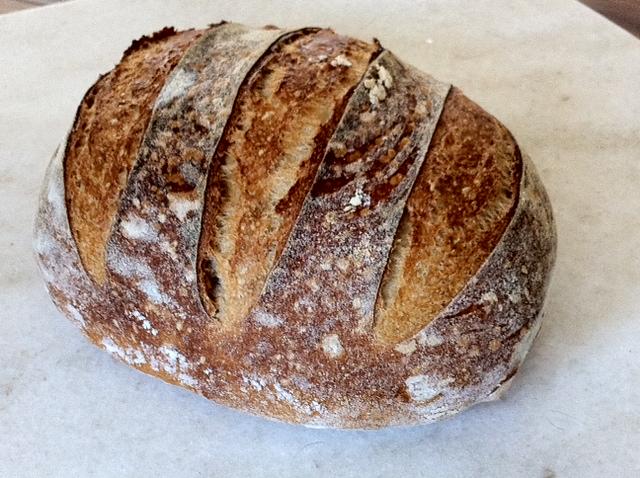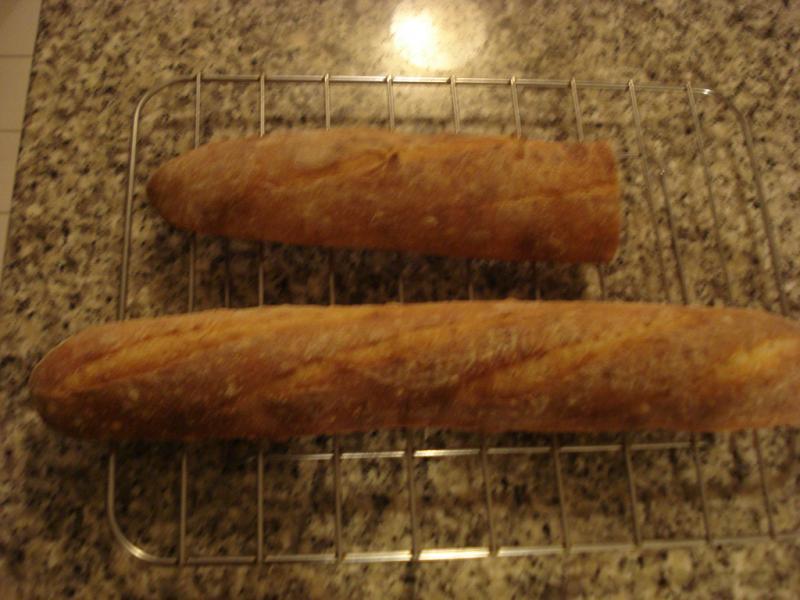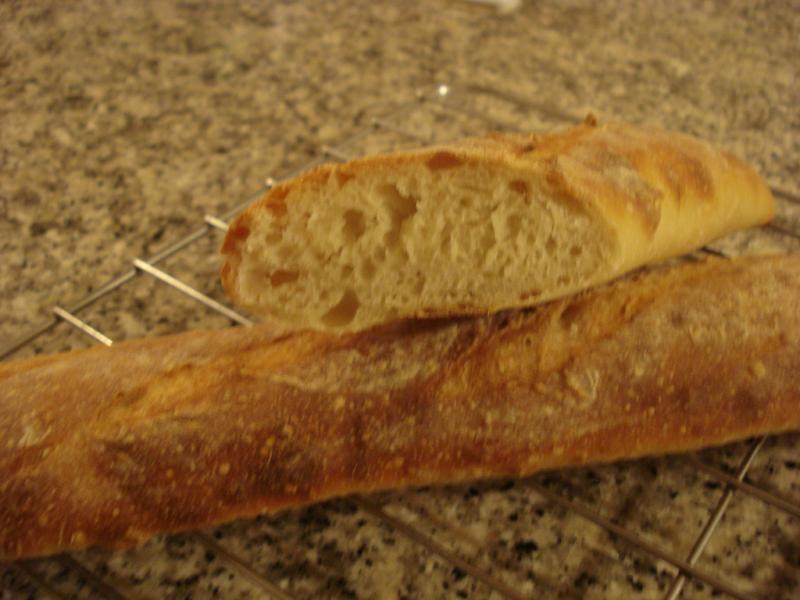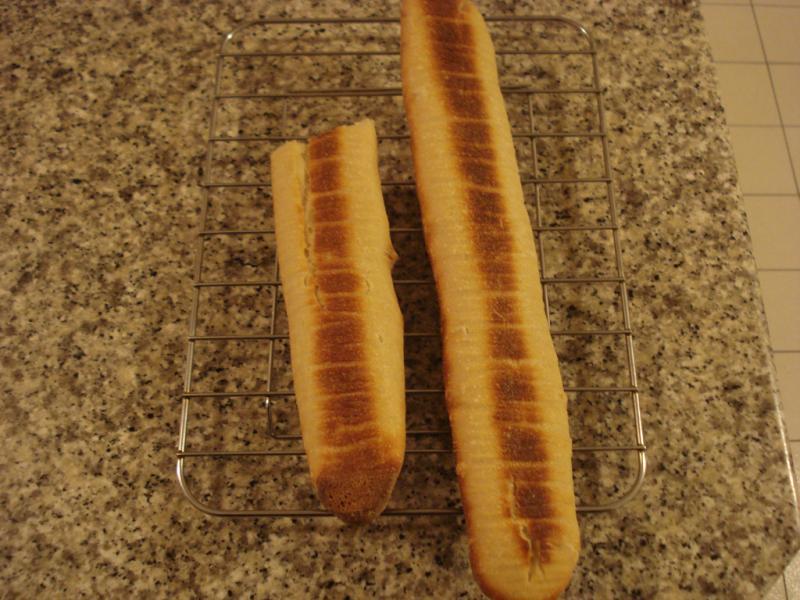Search the Community
Showing results for tags 'Bread'.
-
Do you all test your yeast before using it in a recipe? It seems that every recipe in the universe recommends first putting your yeast in warm water and waiting for it to bubble to ensure its vitality. I have never done this. I just add the powdered yeast to the bowl with everything else. Yesterday I had a little scare because the dough wasn't rising, but when I moved it to a warmer spot it did its thing just fine. The incident gave me pause, but not enough to add this extra step to my baking routine.
-
Hey, I just stumbled upon what looks like an excellent glossary of types of flour available in China in English, Chinese and pin yin. The link is here, hope it helps! Also, a little off-topic but; I just got an email from Pantry Magic Corporate saying that they've been trying to get the new Beijing store (near Worker's Stadium) to close down since mid-February for 'serious non-compliance'. What's up with that? P.S. I'm not connected to that bread web site or Pantry Magic in any way, for you jaded, snarky-types lurking out there!
-
Hi, I'm not sure if this is the right place to ask, but since it revolves around the bacteria used to make idli I thought I'd ask: Are there any breads which use the bacteria that rise idli? Are there varieties of idli which use flours or other grains instead of rice? Thanks,
-
I have a plain-vanilla bread machine on the way from Amazon. I'm unable to bake free-form or in pans in the oven at the moment. I’ve done both successfully in the past. I had a bread machine a long time ago after seeing Julia Child demo them with Jane Brody on her PBS series 'Baking with Julia.' I enjoyed using them for some time, then was able to move on to oven baking both in loaf pans and free form sourdough. Im interested in making just toast and sandwich bread at the moment. I’ve studied the older threads and have gotten some great tips, including the one from andiesenji about removing the blade prior to the last rise and bake. Brilliant! I wish that had occurred to me years ago. Im hoping to use the machine by weighing the ingredients as is the current practice by 'seasoned' bakers. I hope to find recipes that measure 'by weight.' My library has a large number of bread machine books, but these come from the era before most bakers at home had decent digital scales. I did find this ref: http://www.erikthered.com/flwm.html This may be all I need. Does anyone have worthwhile ‘tips?‘ Any further references to more current web sites that measure by weight? Has anyone successfully retarded dough in the refrigerator and then used the machine another day for baking? Ive gotten my yeast from King Arthur, and will use their flour available at Trader Joe’s. Eventually, I may be able to use the machine for the mixing and then bake in the oven. Thank you
-
I am enjoying good success with the Tartine Bread book, and am really enjoying the wild-yeast risen bread I am producing. My wife is also really enjoying it, and just about refuses to eat a sandwich on anything else. I have even modified the process to suit my weekly schedule: I do a 4 hour initial proofing phase in the evening, and then shape it and let it rise for about 18 hours at 50F, baking it the next day when I get home from work. Even with that, I have the problem that it keeps well for a few days (it usually disappears before it stops making great toast), but I dont have the time to be baking a new loaf every 3 days. This leads me to my question. I have been thinking about par-baking off a few loaves of bread so that through the week I can finish the loaves in the oven and have decent bread in the house. Does anyone have any experience with this? Is there a specific internal temperature I am looking for before I take it out and cool the loaf quickly (I was thinking about blowing a small fan across the loaf)? Baking the bread in the dutch oven for the first 20 minutes means that I do not have an issue with the bread browning at all and I get fantastic oven spring, but I am still a bit unsure as to when to remove it from the oven. Thank you, Joshua Attached is an image of a previous loaf. Very tasty
-
I finally got to meet my internet friend, Amanda, in person. She lives in Australia and we originally "met" on a recipe forum many years ago. While she was in the US I wanted to share my sourdough starter with her. I knew she wouldn't be able to take it in liquid form on the plane so I dried some and put it in an envelope for her. She reconstituted it when she got back to Adelaide and made some beautiful loaves of sourdough bread. She writes a food blog: http://www.lambsearsandhoney.com/ There are pictures of her sourdough loaves made with my starter in the blog if you want to see them. They look better than mine... but its fun to know that something I created in my kitchen is now feeding Amanda's family in Australia.
-
Just want some quick advice for a bread pudding-like dessert. I have some left over coffee cake (not a very large piece) which I plan to cube for the pudding. I bet I could use a standard bread pudding recipe, but since the texture/structure of the cake is different than the bread I would normally use, any input is appreciated. Anyone ever done this before?
-
I have a recipe (for Chinese char siu bau) that calls for roughly the following sequence of tasks: 1. Mix hot water, sugar and active dry yeast in a bowl. Let it rest for 30 minutes to 1 hour. 2. Add flour, egg, oil and knead for 15 minutes. Let it rest for 2-4 hours. 3. Shape buns. Let them rest for 1 hour. 4. Bake. I have two questions about this method: * I am wondering how this recipe can be modified to use instant yeast instead of active dry yeast. Typically I modify recipes by adding the (instant) yeast with the dry ingredients instead of adding it to the water. However, in this case this eliminates the first step and a whole hour of happy feeding for the yeast. I am wondering if the rest of the recipe needs to be adjusted if I skip the first step and mix all ingredients together. * I don't understand why the first step requires half hour to a whole hour of waiting. Other recipes that call for active dry yeast simply instruct us to add the yeast to the water and then to the rest of the ingredients. I understand that if we're not quite sure if the yeast is still alive, we can wait a few minutes until it starts to bubble in the water. But why a whole hour? Thank you in advance for any replies!
-
One of my favorite bread recipes from Flatbreads and Flavors is Nane Casoke, or bulgur bread. You take some bulgur, soak it in 2 parts boiling water with a bit of salt and chopped onion for 30 minutes, mix that with flour to make a workable dough, and then roll out thin breads (as thin as you can get given that the bulgur won't flatten too much) and bake directly on stones or bricks in the oven. I bake them to a soft chewy texture, and they're lovely with soups, cheese, even applesauce. Today I'm wondering how they might taste with other grains substituted for the wheat, and that brings up the question: how to prepare another grain to function like the bulgur in this recipe? Would it work to just start with rice or barley or quinoa cooked to 'normal' eating texture, or is there anything else special about bulgur processing that might be important to the final result?
-
articles such as this one are making the rounds today: http://healthland.time.com/2012/02/08/top-10-sources-of-salt-in-your-diet/ this comes from a CDC report. I was somewhat surprised. i used to bake bread regularly but not at the moment. most of the bread i use for toast/sandwich/pasta-related comes from this bakery Nashoba: http://www.slowrise.com/ I get the version they sell to trader joes as its the same as their sourdough just a buck cheaper for some reason as its delivered frozen and defrosts overnight on the shelf. it has 340 mg sodium/50 grams ie 4080 mg sodium/loaf at 21 oz. if you bake your own, what is the sodium/baked loaf that you make ie the sodium ( not NaCL ) per loaf and the weight of the backed cooled loaf? its a certain amount of work to figure this out but Im interested in restarting my baking not for the above but because 'its about time' Im thinking of going with the "Five minute loaf" thread. some time ago in CA there were many locally baked sourdoughs to choose from in the bay area. one was from Nancy Silverton La Brea bread, baked locally and sent frozen to these stores. it was better than the others, and I noted it had more sodium in it. Im only curious about the Home Loaf. it may be similar to commercial or not. if it is then one cuts down on the sodium elseware. thanks PS 1 tsp 'salt' = 2400 mg sodium
-
I finally got the room for a large freezer and I am now going about stocking it. Now I love fresh baked bread, but I simply do not have the time to make fresh bread every day. As such I wondered whether it is possible to freeze dough or perhaps half-baked breads for later and if so, at what point do you freeze it and why?
-
I ran across a reference to black brioche and my Google-fu is sadly lacking. Does anyone have a recipe to share?
-
Why don't we add the same stuff commercial bakers use to prolong shelf life? It shouldn't be that hard to get mixed into dough,probably a little butter or cream would solubilize it. I'd love my baguettes to last a few days.
-
I've had brioche thats fine and crumbly (almost poundcake-like) as well as brioche that pulls apart in velvety strands. Apart from the fact that its buttery, eggy, and rich.. why do we refer to them with the same generality and which do people prefer more?
-
I see where people talk about bread recipes and mention a % of hydration. How do you figure that? When I make bread, I start with the amount of water or other liquid in a recipe then add the dry ingredients and rapid rising yeast to a cup of flour and beat it with a whisk on the KA mixer until aerated. Then I switch to a dough hook and add flour without measuring. i add a little at a time until the dough hook will work the flour without the dough sticking to the bottom of the bowl... well, not stick too much. Then I let the KA knead the dough for a few minutes before turning it out with a little flour to knead until it is smooth and elastic and can be rounded to form a smooth and stretchy top. At that point I oil and cover in a bowl until risen. I like my method because I can vary what I add like some milk or potato flour or egg and or oil and not worry about changing the recipe because I always add flour until I get a proper dough. So I do not understand what it means or how one figures 'hydration' percentage.
-
This is a 75% hydration sourdough, with 3-4 hour initial fermentation and finished ~12 hours in a fridge. Then it was shaped, slashed with the long edge of a kitchen knife (at a ~30' angle) and placed into a 475' oven. I did not use a cover or a crock pot to bake. The problem I have is that my slashes always seem to close up, often opening at the bottom. If you look at this picture closely, you can see that there are remnants of slashes on the top of the bread (aside from the humps) - those slashes are from me slashing the bread again ~5 minutes after the bread went into the oven. I have never been able to get good scores and they always seem to close up. What am I doing wrong and what can I do to correct these problems?
-
HI All- I am making the stuffed breast of veal recipe in the december, 2011 BA and in reading the re cipe, it uses white bread for the stuffing. This veal breast is seared and then braised in liquid for 3 hours. It seems like the stuffing would be really wet and heavy. Are there veggies that can be substituted in this stuffing that might make it lighter than the bread? I was thinking maybe sauteing some squash, shredding it and mixing it in as a portion of the bread. any other ideas would be appreciated. Thanks,
-
I'm just learning to bake bread and I'm confused about what primarily influences the crumb or texture of the bread. For example, consider pain de mie. Made some yesterday for the lst time using King Arthur recipe and AP flour in a lovely new USA pullman pan. It took a long time for both rises but looked perfect before baking. Came out in a perfect,compact, tasty rectangle but the texture is not as fine as I expected. I accidentally omitted the 3 T of potato starch but wouldn't think that would affect the texture (?) Could it be our mineral laden water? (We have a well and live in limestone rich north Florida). Thoughts?
-
Hey Everyone In the past weeks, I've sort of rekindled my interest in bread baking. Having a copy of Bread Bakers Apprentice, I made the Pain a l'Ancienne, which came out wonderfully. I'm still working on the one actually, there have been times where the loaves come out picture perfect, the scores open up, the baguette browns evenly and is crisp, they look like they belong in a small cafe in the France. Then there are other times where they come out sort of flat, and the scores are barley visible. Anyways, I think I'm narrowing that one down. But my question here is about the Lean Bread recipe from "Artisan Breads Every Day." Hopefully, I dont get too wordy, but I sort of like this recipe for a few reasons. Firstly, in the recipe from this book for French Bread with (I think) 66% hydration, it came out waaaaay to light and fluffy, like sandwich bread in the shape of a baguette or boule. I like the Pain a l'Ancienne recipe with 80% hydration, but I suppose thats not really meant to be shaped, Reinhart gives instructions to just sort of stretch it out into shape, not really forming it and tightening the gluten on the outside, but it does have a nice crumb, and most of the time, I can get the crust crisp. And it seems in between those, is the Lean Bread with 75% hydration. This also had a nice crumb, not and nice as the 80% hydration dough, but I still thought it was acceptable. So I'm wondering about my baguettes. The pictures are the 75% hydration Lean Bread recipe from Artisan Breads Every Day. I followed the instructions, formed them into baguettes, and let them proof 1 hour covered, and about 45 min uncovered. I read on a website that the times Reinhart gives to proof are guidlines, and its more accurate to test by poking the dough, so I did that. The dough had very little springing back, which I took as a sign of bring proofed. Into the oven they went with steam, and they did spring up, but the scores opened very little, and the bottoms baked quite unevenly. Can someone give me a few tips on what I can do for more even baking, and to have the scores open up? The pictured loaves were baked on a sheet pan at 450f. Am I over proofing them? Hopefully this isnt getting too long, but if I still have your attention...what seems weird to me is that I made a small batch of 80% hydration dough, and one day later I took off a piece and shaped (or tried to) it into a batard, I let it sit for like 10 or 15 min probably after bring shaped, and it went into the hot oven...then it sprang up like crazy and developed a beautiful ridge (see the picture with the mussels) and was perfectly crisp, no blond spots on the bottom, even brown...I'm not kidding, this is the best one that has come out of my oven. This little batard was baked on the back of a cast iron pan that was preheating with the oven. Then 24 hours later with the same dough, the baguettes I baked were ok, just sub par, could barley make out the scores. What accounts for the difference? I cant imagine it was being baked on the cast iron pan vs. a sheet pan. Anywho, I'm just wondering what steps I should take after the 75% hydration dough come out of the fridge after 24 hours of cold fermentation to get a decent looking and even baked baguette. Thanks for reading this and any help provided. :-)
-
Hi everyone, I was hoping you help me recreate Joel Robuchon's mini french baguettes. I have had them many times in l'atelier in Las Vegas, and I think it is the tastiest baguette I have ever had. This is what they look like: I have looked for the recipe all over the internet with no luck. Any help or suggestion would be greatly appreciated!!
-
What bread is best for panini made at home? I like a crusty bread in a panini but a baguette or even a hoagie roll goes stale so fast. Is there a frozen bread that can be baked a la minute?
-

Why does the quantity of yeast in a bread dough matter?
Shalmanese posted a topic in Pastry & Baking
The entire point of fermentation is to allow the yeast to grow right? Doesn't that mean a bread dough with half the amount of yeast mean that you just have to wait an extra doubling time to get the yeast back to the original level? Sure, the bread will rise slower but the end effect should be the same right? Or am I misunderstanding something about bread science? -
i just made a million muffins (not quite) and some cranberry n pumpkin breads for thanksgiving...trying to get ahead of the game and now realize its only monday...should i freeze them or just put them in fridge or bag on the counter.....the time for this question was before the oven went on but need help, thanks
-
I'd like to do CI's Rustic Italian Bread, but a stand mixer is required. Can this recipe be done by hand, and if so, any tips for doing it?
-
Greetings, bread experts! I recently visited a friend in Cincinnati, and was lucky enough to visit the Farmer's Market in Hyde Park, outside the city, on a Sunday, where I experienced the best bread I've ever eaten, baked by the talented folks at Blue Oven Bakery. Here's their site: http://blueovenbakery.com/homePage.php So I managed to hold up the substatial line that had formed, by peppering the people behind the counter with the question: how is the bread so moist? It was a sourdough whole wheat (I think all their breads are sourdough), that was so moist, it was almost as if it had butter on it. I'm an amateur baker myself, and bake for the Farmer's Market as well, but I had never been able to get a moist loaf of that caliber, as my hydration needed to be at 61% to rise well. They informed me that their breads are hydrated at not less than 75%, and up to 80%! How is this possible? I noticed that the breads were not terribly tall, and had lovely open work bubbles, characteristic of a well-hydrated loaf. I tried experimenting, adding more liquid to my formula, and . . . the bread exploded sideways, even though it was well slashed. Hmmmmm. Any thoughts? Here's my recipe: 112 oz. mixed whole wheat, strong white and AP flours; 2.5 oz. ground flax; 1 oz. flax seed; 63 oz. water; 1 t. instant yeast; 24 oz. 100% hydration overnight biga; 1/4 t. ascorbic acid; 3T salt. Would the sourdough batter hold more moisture? Your help gratefully acknowledged, thanks.
















